Round Table: Embodied design
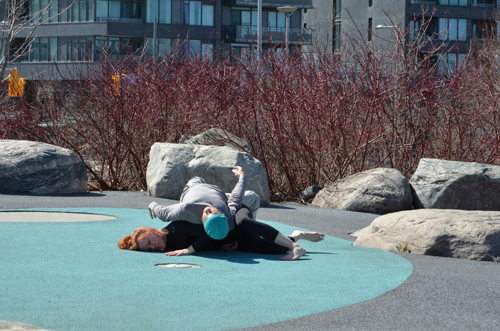
BIOS/
HEIDI CAMPBELL, SENIOR LANDSCAPE DESIGNER AT EVERGREEN, HAS A MASTER OF LANDSCAPE ARCHITECTURE AND A BACHELOR OF EDUCATION. SHE HAS MORE THAN 25 YEARS OF EXPERIENCE IN THE DESIGN OF OUTDOOR SPACES, WITH A STRONG EMPHASIS ON CREATING NATURAL ENVIRONMENTS FOR PLAY AND LEARNING. A QUALIFIED TEACHER WITH A FOCUS ON COLLABORATIVE PLACEMAKING, SHE HAS WORKED WITH ARTISTS, VOLUNTEERS, AND COMMUNITY GROUPS TO ENVISION AND CO-CREATE PLAYFUL, INTERACTIVE, AND EMERGENT PUBLIC SPACES FOR PEOPLE OF ALL AGES.
REAL EGUCHI, OALA, IS A PRINCIPAL OF EGUCHI ASSOCIATES LANDSCAPE ARCHITECTS/ BREAL ART + DESIGN. HIS KEY CURRENT INTERESTS INCLUDE “SUSTAINABLE BEAUTY,” AN AESTHETIC THAT DERIVES FROM THE TRADITIONAL JAPANESE SENSIBILITY OF WABI-SABI AND THE AUTHENTIC EXPERIENCE OF AWE IN RELATIONSHIP TO NATURAL PROCESS. THROUGH HIS LANDSCAPE ARCHITECTURE/ART/SOMATIC-BASED PRACTICE, REAL EXPLORES LOSS, GRIEF, AND CONNECTION, AND IS INSPIRED BY THE MULTIPLICITY OF WHOLE RELATIONSHIPS THAT NON-PRESCRIPTIVE, PROXIMATE LANDSCAPES CAN PROMOTE.
ERIC KLAVER, OALA, IS A MEMBER OF THE GROUND EDITORIAL BOARD AND A PARTNER AT PLANT ARCHITECT.
SVETLANA LAVRENTIEVA, OALA, IS A TORONTO-BASED LANDSCAPE ARCHITECT AND ARTIST. SHE SEES THE DESIGN PROCESS AS COLLABORATIVE, AND OFTEN SEARCHES FOR INSPIRATION FROM DANCE, FASHION, PERFORMANCE ARTS, PHOTOGRAPHY, AND CINEMA. AS A PRACTISING LANDSCAPE ARCHITECT AND AS A PAINTER, SVETLANA’S WORK EXPLORES VARIOUS STATES OF NATURE. FORMERLY TRAINED AS A DANCER, SVETLANA CONTINUES TO CONNECT PHYSICAL MOVEMENT WITH LANDSCAPE. SVETLANA RECEIVED HER BACHELOR OF ENVIRONMENTAL DESIGN FROM THE UNIVERSITY OF MANITOBA AND HER MLA FROM THE UNIVERSITY OF TORONTO.
ANDREW LEVITT COMPLETED HIS UNDERGRADUATE STUDIES IN ARCHITECTURE AT THE ARCHITECTURAL ASSOCIATION IN LONDON, AND HAS A MASTER’S DEGREE IN COUNSELING PSYCHOLOGY FROM CHESTNUT HILL COLLEGE IN PHILADELPHIA. AFTER WORKING AS BOTH AN ARCHITECT AND JUNGIAN-ORIENTED PSYCHOTHERAPIST, ANDREW JOINED THE UNIVERSITY OF WATERLOO SCHOOL OF ARCHITECTURE, WHERE HE TEACHES IN BOTH THE GRADUATE AND UNDERGRADUATE DESIGN STUDIOS. HE IS THE AUTHOR OF THE INNER STUDIO—A DESIGNER’S GUIDE TO THE RESOURCES OF THE PSYCHE, PUBLISHED BY RIVERSIDE ARCHITECTURAL PRESS IN 2006. HIS MOST RECENT BOOK, LISTENING TO DESIGN, WAS PUBLISHED BY REAKTION BOOKS IN THE SPRING OF 2018. ANDREW HAS TAUGHT, LECTURED, AND PRESENTED SEMINARS AT UNIVERSITIES AND CONFERENCES IN CANADA, THE UNITED STATES, AND EUROPE.
TERENCE RADFORD, OALA, BCSLA, HAS A BACHELOR OF VISUAL ARTS FROM THE UNIVERSITY OF VICTORIA AND A MASTER OF LANDSCAPE ARCHITECTURE FROM THE UNIVERSITY OF BRITISH COLUMBIA. AS AN INDIGENOUS PRACTITIONER AND MEMBER OF THE METIS NATION OF B.C. (MNBC), TERENCE BELIEVES IN A SYSTEMS- BASED APPROACH TO LANDSCAPE DESIGN AND HAS WORKED ON A NUMBER OF PROJECTS FEATURING GREEN INFRASTRUCTURE, INCLUDING GREEN ROOFS AND RAIN GARDENS. HE BELIEVES EVERY PROJECT IS AN OPPORTUNITY FOR SITE RESTORATION AND ENVIRONMENTAL EXCELLENCE.
LAURI SUE ROBERTSON, PRESIDENT AND OWNER OF DISABILITY AWARENESS CONSULTANTS, HOLDS DEGREES IN SOCIAL WORK, CRIMINOLOGY, AND HUMAN RESOURCES. SHE IS A FORMER PRISON GUARD AND SOCIAL WORKER, AND HAS 15 YEARS OF EXPERIENCE AS A HUMAN RESOURCES MANAGER. SINCE 1995, SHE HAS BEEN DELIVERING DISABILITY AWARENESS TRAINING, CONSULTATION, AND SITE AUDITS FOR CLIENTS WHO SEEK TO CREATE ACCESSIBLE ENVIRONMENTS. SHE WAS ON THE PROVINCIAL COMMITTEE FOR THE EMPLOYMENT STANDARDS OF THE ACCESSIBILITY FOR ONTARIANS WITH DISABILITIES ACT, AND HAS WRITTEN MANY TRAINING MANUALS FOR THE PROVINCE.
PHILIP SHEPHERD IS RECOGNIZED AS AN INTERNATIONAL AUTHORITY ON EMBODIMENT. HE TRAVELS THE WORLD TEACHING THE EMBODIED PRESENT PROCESS™ (TEPP), A UNIQUE SET OF PRACTICES HE DEVELOPED FOR GETTING US OUT OF OUR HEADS AND RECONNECTED WITH THE PROFOUND INTELLIGENCE OF THE BODY. HE IS THE AUTHOR OF TWO BOOKS: NEW SELF, NEW WORLD: RECOVERING OUR SENSES IN THE TWENTY-FIRST CENTURY, AND THE RECENTLY PUBLISHED RADICAL WHOLENESS: THE EMBODIED PRESENT AND THE ORDINARY GRACE OF BEING.
AMY TESSLER HOLDS A BACHELOR OF EDUCATION FROM MCGILL UNIVERSITY AND HAS COMPLETED A MASTERS-LEVEL POST-GRADUATE PROGRAM IN INTEGRATIVE PSYCHOTHERAPY AT THE LIVING INSTITUTE. AMY IS ALSO TRAINED IN ADVANCED EMDR THERAPY AS WELL AS STRUCTURAL DISSOCIATION THERAPY. SHE IS FASCINATED BY TRAUMA’S EFFECT ON THE BRAIN AND BODY AND HOW YOUNG RELATIONAL WOUNDS INFORM OUR CURRENT RELATIONSHIPS. AMY IS DEVOTED TO THE HEALING PROCESS AND USES SOMATIC AND RELATIONAL MODALITIES TO HELP CLIENTS RENEW THEIR SENSE OF INNER TRUST WHILE NURTURING GROWTH OF ALL KINDS.
Real Eguchi (RE): Let’s start somatically, eyes closed, holding each other’s hands, focusing on the breath…now, saying two words about how we feel, along with a gesture that relates to how we’re feeling. I’m excited and I’m nervous.
Amy Tessler (AT): I’m feeling excited and curious.
Philip Shepherd (PS): I’m feeling fairly present, and appetent for what is to come.
Terence Radford (TR): I’m feeling pretty anxious, which I always feel after driving on Highway 401.
Svetlana Lavrentieva (SL): I’m feeling at peace.
Lauri Sue Robertson (LSR): I’m fine. [Gesturing] That’s sign language for fine, by the way, or happy.
Heidi Campbell (HC): I’m feeling energized, but a little nervous.
Eric Klaver (EK): I’m feeling content, and intrigued about what’s going on.
Andrew Levitt (AL): I’m happy to be here with all of you, and I’m looking forward to this evening.
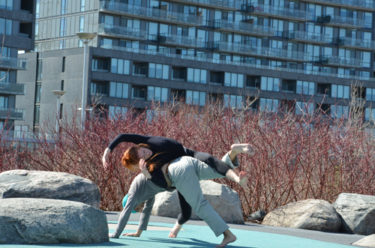
RE: I’ll start with a definition of somatics: relating to the body as a source of information and wisdom. Somatics suggests a more holistic view of being, with the head and body in a reciprocal relationship.
In my late 50s, I started practising something called ecstatic and contact improv dance (which Amy also does). It’s a form of somatics. I was glued to the wall for the first few months because I was so afraid, and a lot of stuff surfaced for me, like being racialized when I was younger. I realized how traumatized I was. I felt very vulnerable, but I also felt joy in my body, and I couldn’t understand that, so I started researching, and learned about somatics.
Leanne Dixon and Real Eguchi perform contact improv, a somatic postmodern dance form. VIDEO/Real Eguchi
For me, it all comes down to accepting myself and my body. I want to consciously integrate my somatic awareness into my work, which I have not really done yet, though I’ve written about mindful design. I think that many people carry trauma, or emotional injury, and I’m wondering how that influences how we design landscapes, and how we live in them.
To get at these questions, I’d like to pretend that we are the somatic focus group on a larger design team, and we’re going to design something—say, a park. Our goal is to create a landscape that promotes emotional and physical wellbeing and growth for individuals, and health of communities, nature, and the environment. This is a huge undertaking! I believe that in our profession we pick and choose what we want to focus on, and what we ignore. Vulnerable communities, and other species, are often left out, though this is improving. I think that somatics can inform how we embrace people and species who are different from ourselves and different from the mainstream.
How do we design lived-in landscapes that somatically support people in their growth and healing?
PS: I’d like to add to your definition. Our view of somatics tends to be defined by the border that we hold around the body, so it becomes introspective. You can pay attention to what is happening in the body, or you can attune to the body’s understanding of what is happening in the world. They’re very different things. Somatics in practice, to me, is more about the body’s attunement to the world.
You watch kids running around, and none of them is thinking, “What am I feeling?” Instead, it’s like the world is calling to them to come and play, and engage, and they’re at an age in which they haven’t been inculcated in self-consciousness, they’re still at an age of world consciousness. I think somatics, at its base, is an engagement with the body’s intelligence in such a way that it opens us to the world, not in an enclosed way of introspection of the self that feels like it’s held separate from the world within a boundary.
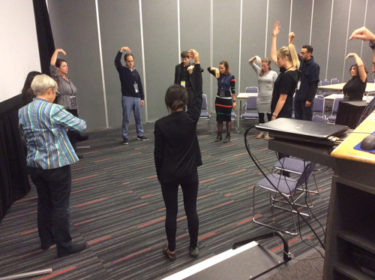
AL: The product is less important than the process, and so maybe the question for landscape architects is: how could the training of a landscape architect change so that instead of prescribing outcomes, the focus is on supporting instinctual creativity, aliveness, etc.?
SL: When I go on a site visit, I’m not just there to take photos and measure the grades. I want to experience the space through physical movement in addition to visual sensations. As designers, we need to look at how the body moves through spaces. What kind of shapes are being created and what kind of forms start to evolve? I’m trying to get away from the two- dimensional precedent imagery that we’re constantly being bombarded with, and I try to get inspired by the surroundings.
VIDEO/ Svetlana Lavrentieva, Rennie Tag and Lisa Sandlos
AT: For me, somatics is about how I can use my body to discern what I’m perceiving in the world, and to understand that information and to process it through my body’s intelligent filters, which guide my choices and allow me to recognize that I have choices. It widens our limitations beyond cognitive thinking for decision-making. Therein, the question becomes, what are the sensations in my body allowing me to make of my experience in the world in this moment, and how can I use that information to make choices, or to understand my agency?
RE: Gabor Maté posits that from childhood we all are somewhat traumatized, that we live in an addictive culture. If we’re not whole, it allows other people to control us. It’s the notion of control from the outside that I’m interested in.
PS: In our Western culture, we’re used to being in our heads, and taking charge of the body, taking charge of our lives, and it creates a duality within us whereby we seek that same top-down control from others, whether that’s politicians, or celebrities, or whatever. I’m wary of language that reinforces this division. It’s such an easy thing to talk about, wanting to use the body. You can’t set that up without imputing a division. If you are using the body, there is a separation. I think our primary relationship is our relationship to the body. That’s the template for all other relationships, and if we divide, and compartmentalize, and fear a lack of control, that’s how we relate to bodies. What we create becomes bordered, and compartmentalized, and controlled. Our boundary around the self as we experience it, holds us separate from nature, holds us separate from nature’s intelligence, such that we have to choose to notice it, which is so different from feeling it as a seamless part of who we are.
AL: When we’re talking about the body, we’re doing something odd, because the body doesn’t have words. We’re thinking of something and ascribing it to the body, so what does the body have? Is it pleasurable, or is it not pleasurable? Sure, we have to give words to emotions, but there’s a level that the body operates on that’s instinctive. The wisdom of the body results from millions of years of our organs being developed. I’m not thinking about secretions from my kidneys right now. I trust my kidneys to be doing all they need to do. There’s an intelligence on that level, but there’s also a quality of animation, and aliveness, an instinctual language the body responds to, that we’re often in exile from. And I think our education sends us there.
PS: The primary wound in our culture is the division of our thinking from our being. We have been taught in school that we can think more clearly if we shut down the body’s energy, and suppress it, and fill our heads with information and concentrate on that. What my work addresses is bringing our thinking, and our being, back together. When that happens, you feel every thought, and every sensation is recognized as a form of thought.
LSR: That separation of mind and body goes much further back than schooling. Think about your earliest years, sitting someplace with your parents and them saying, “Don’t fidget.” We’re taught from our earliest years to separate what we’re thinking from what we’re feeling, and how we act. We spend our whole lives separating our minds from our bodies.
AT: In talking about landscape architecture, and setting up structures, how can we invite people back into feeling safe with their impulses, so we’re not just organizing our structures around protecting ourselves from injury?
RE: It seems safe to say, then, that we seek too much control with our minds because we are fragmented.
AL: We couldn’t exist without the capacity to think, so thinking is not the problem. It’s not helpful to demonize a particular part of ourselves. But we can acknowledge that perhaps we overvalue thinking. You can see that in education. Everyone has their own way of being present, whether that’s coming from somatic experience, or not. Human beings are really complex, and we’re just at the beginning of investigating what a human being is.
PS: There are a lot of ways of not being present, as well.
RE: The question is, then, how do we design landscapes that accommodate the range and complexity of how we are as humans? And I think it’s important to remember one definition of natural play as being freely chosen, self-directed, and intrinsically motivated.
HC: When I work with very young children, I find they have impulses that are being restricted in their environments—school is one, but the homescape is another. In this era of risk-averse parenting, children don’t seem to have the space and time for their own creativity, their own body impulses, their own responses. We make a lot of assumptions about what they need. I’m encouraged by the user-centric behaviour-mapping that’s coming into design language, but we’ve got a long way to go in hearing children’s voices in landscape. That being said, I think landscape architects are well positioned to make an impact, along with urban planners, urban designers, and architects. What we need to do is to open up space for children to be the architects of their places, and step back, get out of the way. Messiness is something that our culture doesn’t seem able to reconcile.
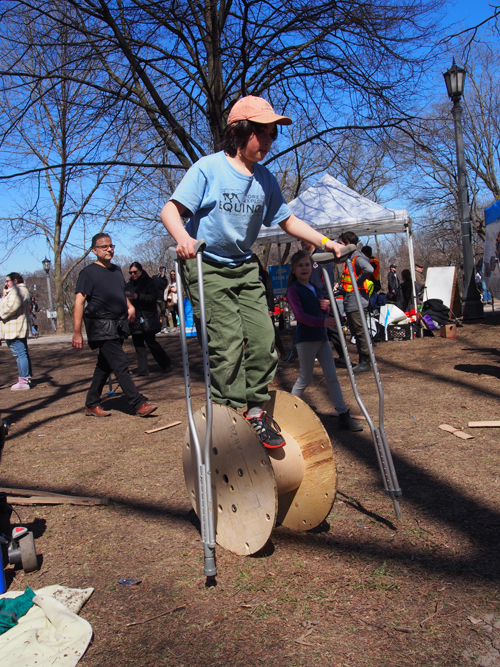
RE: What happened to adventure playgrounds?
HC: Adventure playgrounds have seen most of their success in the U.K. But in North America, everything is built with a heavy dose of risk management and litigation at the forefront. What is great about adventure play spaces is that they are filled with loose materials—including wood, recycled tires, rope, and tools— and playworkers (trained play experts) give children the space to take risks and explore their imagination.
The “loose parts play” movement is on the rise, which means that, in a very cultured landscape, children can play with different materials and try to shape their environments a little bit. The social aspect of that is amazing. Some teachers in Ottawa opened up space in their schoolground for free play with loose parts, and what they found was that children who had been on the margins socially were engaging in the space, and coming to them, and wanting to be part of this daily. Other teachers were noticing that their students who wouldn’t speak in class were speaking outdoors in the natural environment, and were expressive verbally. They were also moving their bodies differently. On a school landscape, so many things are prescribed, and it’s so based on surveillance, and being able to see everywhere. Children don’t have anywhere to let their hair down, so to speak, and play together in interesting ways.
EK: When we do public consultations, there is a tendency to catastrophize things. People immediately go to what kind of disaster, what kind of terrible things can happen to children in this environment, rather than, “What can they actually be doing in this environment?”
LSR: It’s important that any play area should have multiple facets. Some children like to be in a more enclosed space, others in a wide-open space. Some children might like to play in big groups, and other kids can really only cope with one or two other people at a time. So, you need a combination of environments. Whether the kids are disabled or not is not the issue, but just what each individual kid is bringing to the party. We all bring our own histories to our interactions. I had a really violent dad, so I wouldn’t play with other kids who were really vigorous, because in my experience, that was a prelude to getting hit. You have to have different sorts of environments for each child to come out and say, “Okay, I feel safe in this particular spot. I’m comfortable here to play.”
AL: As more people speak about their experiences, and more people process their experiences, we’re going to have an awareness that changes what design is. There are introverts and extroverts, there are people who will wake up wounded, there are people who will go to bed wounded. Our whole notion of the individual is changing, and with that is a design shift, especially around the idea of user experience, which now might incorporate psychological input.
SL: There are a series of spaces in Toronto, called Wave Decks. The structures are definitely playful, though it’s not a playground. You often see people of different ages and mobilities running or walking up and down the decks, even skipping up the steps. As designers, we can start thinking about how to incorporate elements that allow not only children but also adults to play in spaces that are “designated” as play, but that are on our daily routes. These elements do not have to be complicated. But they do have to invite people to play, to feel safe, and to open up both bodies and minds.
AL: On an urban level, we’re so organized around getting through the city that we’re not really thinking about just being in the city. I think designers need to get more inspired around that kind of place in which people can live more fully. I think that quality of a space where one can play very simply has lasting benefits.
EK: Here’s a funny example about play. With the King Street Pilot Project in Toronto, some of the restaurateurs were protesting by playing a hockey game in front of a restaurant, as if it were some sort of satire. I thought, that’s poor satire, because it’s actually really great that you could play hockey on King Street!
RE: I’d like to talk about risk in play environments, and in landscapes in general.
HC: In 2016, a position statement on active outdoor play was spearheaded by CHEO (the Children’s Hospital of Eastern Ontario) and endorsed by a diverse, cross-sectoral group of partners, stakeholders, and researchers, including the B.C. Injury Research and Prevention Unit. It basically says that if we don’t allow children to take risks, we are at risk of even more catastrophic injuries: “Access to active play in nature, and outdoors, with its risks, is essential for healthy child development. We recommend increasing children’s opportunities for self-directed play outdoors, in all settings: at home, at school, in childcare, the community, and nature.” This has really opened the door for a lot of different conversations at the institutional level, provincial level, for inspectors, childcare centres, and educators. As a society, we need to recognize the difference between danger and risk. And we need to value long-term health and fun as much as we value safety. Experiential education, and more time for free play in nature, is really in view now.
LSR: There’s a wonderful playground right near my house, and it’s got a rubberized ground surface, so I can go on it in my wheelchair. I can go up to the swings, the seesaw, and whatever, and if I were there with a little kid, or if I were a little kid, I could play in this playground. Wheelchairs don’t roll on wood chips. We also sink right into gravel, sand, and dirt. The rubberized surface is so great, because if you fall on it, you don’t break anything, and the chair will roll on it, so it’s firm, but it’s soft—it’s terrific. Anybody could play on it.
RE: When you face physical challenges in the landscape, how does that affect you emotionally?
LSR: It makes me furious. When I got here tonight, for example, the building had an atrocious ramp, it had to be at an angle of about 45 degrees. I couldn’t possibly have done it alone, and I’d have been furious if somebody had expected me to. If I go to a park, and the walkway is made from logs—accordion logs—it’s very nice and rural and everything, but I can’t use it.
AL: It’s incredible that society is in the hands of adults, yet there are so many people who are victims, or are not served. Sometimes I think we need a kind of mass apology, so we can start again, and say, “I’m sorry. We made significant errors in our assumptions, let’s start again.”
SL: We’ve talked a lot about risk management today. When I sit down to design, that’s not the first thing I think about. It’s one of the things, but it’s not what inspires me.
TR: Especially in school playgrounds, we as designers can get caught up in trying to fix problems, address issues, and create something stable—something that’s risk averse, or accessible, or easily maintained, and on budget—but there isn’t necessarily a real focus on the process. Working with Indigenous communities, their interaction with landscape is very different. They have a very different viewpoint on it. There’s a respect for the environment, and the ecology that’s there, and an understanding of how that develops, and how to engage with it.
I grew up in a rural environment, and I’ve been living in the city for quite some time now. I view the city environment as a dead space. Our buildings, our walls, our materials, are all meant to deter life so that the building can be stable and last a long time. It’s as if we want to create something that is not living, because if it’s not living, it’s stable. We design our cities so that they’re stable and they’re not going to change. We have a real aversion to letting ecology, or letting natural processes, shift that.
PS: I remember, as a kid, finding an ant crawling on my finger, and I’m feeling it, and I’m discovering the world, because a child innately understands nature as its most intimate teacher. In the adult world, nature is a form of decoration.
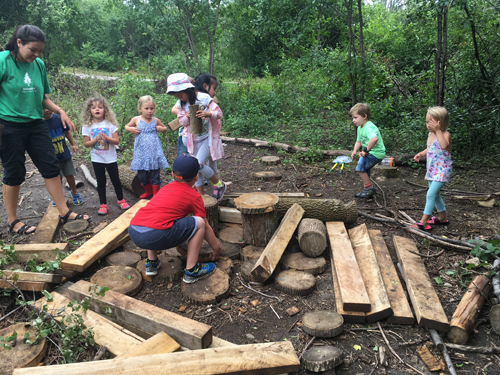
LSR: Our society tries to push us into little boxes. People are still, in many cases, designing for the greatest possible number of people. Seventeen percent of the population has at least one disability, and if you include our friends, and our families who go places with us, you’re looking at about 50 percent of the population that’s impacted, at some point, by living with people who have disabilities. So, to say that such and such a landscape or landscape feature doesn’t need to be inclusive, or it doesn’t need to be an environment where Indigenous people would be comfortable, or it doesn’t need to be an environment where women feel safe to walk, or it doesn’t need to be an environment where people with disabilities can function, you’re ignoring large percentages of society. Everybody’s trying to design for the middle-class, white male.
TR: I don’t want to speak for all Indigenous communities. We’re each different. But in designing with Indigenous communities, there are differences in the symbolism that’s used, and the way that plants are treated. Probably the biggest difference is with the programming—how the site is used by the community. The design is almost secondary to how the community chooses to engage with it, and how they’re going to activate it, and how, through their own process of being, they’re going to change the meaning of that site through their relationship with it. We can design to facilitate this as much as possible, but in the end, the community takes ownership of it, and the design grows through a natural process.
AT: I like that you’re speaking about a way of being with the environment, and I’m curious about how we can change the relationship between being and the living city. How, for example, can we be comfortable with what we’re feeling, with all the flashy stimulation of the city? How do we learn to recognize our own needs: when we need to rest, where we can rest in the city, when we want to play, etc.? How can we listen to our rhythms again?
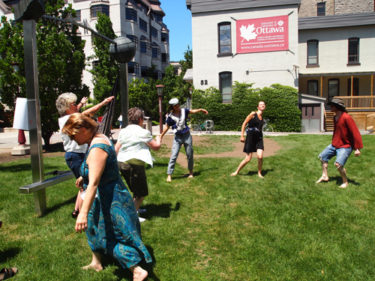
RE: Perhaps we’re talking about fear of uncertainty, fear of nature, fear of others, fear of risk, and the need for play. Play allows us to negotiate those things, and the earlier it happens, the better.
PS: We have a cultural commitment to safety, but we confuse safety and security. There’s a belief that you can make yourself safe. The reality is, if you’re alive, you’re not safe.
There is a security of being—whatever circumstance you find yourself in, you can return to that security of being—but it requires a permeability to the world. It requires a felt relationship. There is no security outside of relationship. Safety comes out of relationship, and security opens you to relationship, so you feel held by the present, held by the natural world. You discover yourself through that relationship. Grasping for safety is a huge cultural thing that is fear-based, and it’s almost oblivious of the embodied somatic place of rest, which brings you back to the security of your being.
I like Donald Winnicott’s observation that play is the one activity where the whole of the personality is invited to be present.
AT: From my understanding of trauma, in our limbic system we’re really caught up in re-living past events, and our bodies are anticipating danger. It’s really difficult to integrate and recognize the present. While we’re never actually safe in that kind of way, we also can’t get aligned with our security-based mechanisms and with the parts of us that can feel grounded here, or with the parts of us that can feel like I have an ally, or I have support, or I can make a boundary if I need to. If we don’t know within ourselves that we have this agency, then it’s challenging to be present in a way that we can see the world through the eyes of option, through the eyes of engagement.
RE: Should we design landscapes that provide for that safety or security of being, but at the same time, allow for risk-taking? Maybe the landscape can be a safe container for somatic-based, cognitive behavioural therapy.
TR: Maybe it’s less a question of the design, and more about how we can add layers to make a space more complex. Instead of just being a space I walk through, this is also a place I sit, this is a space where I eat berries off of bushes, this is a space where I can lean against a tree, this is a space where I can take a nap. How can a path be more than just a path?
PS: There’s a real tendency to design landscapes that communicate to the user what your relationship with that landscape is. The challenge is to design a landscape that doesn’t define that, that is open to curiosity, and inquiry, and play.
SL: As design professionals, how do we use our imaginations to design so that everyday experiences can become different? To make it an adventure every day, or maybe a risky adventure…
AL: Risk is such a legal term. What’s left behind is adventure. People move quite naturally into environments that are interesting, yet we end up talking about risk. The issue is: getting people to be alive, enjoying an adventure.
AT: Leaving safety aside, I think we’ve become afraid of failure, afraid of making mistakes. But when you’re learning anything, you’ve been making mistakes. What environments are going to allow us to feel comfortable learning?
SL: We can plan everything to be safe and protected. We can sit around the table and draw everything to meet the latest standards and to minimize risks. We take risks every day by crossing the street, by riding bikes, by walking on sidewalks. We should embrace risk, and, hopefully, great experiences will happen.
RE: We didn’t get around to discussing the design of a park—the physical elements and qualities of landscapes—that I proposed at the beginning, but from a somatic perspective, as a summary: if a community planted an orchard in a park, it’s nourishing to the body, there is potential for community education and engagement in the planting, maintenance, and harvesting, there’s a risk that it’s not going to grow well, there is the uncertainty each year of what fruit can be harvested, there is the challenge that unwanted wildlife will come to the park, there is the likelihood that the fruit is not going to be as perfect as what you’d get in the grocery store… Maybe this is a good example of all the things we’ve been talking about tonight.
AT: It shows us, too, all the cycles of life, that we can be okay with things coming to life, and dying, and everything in between.
